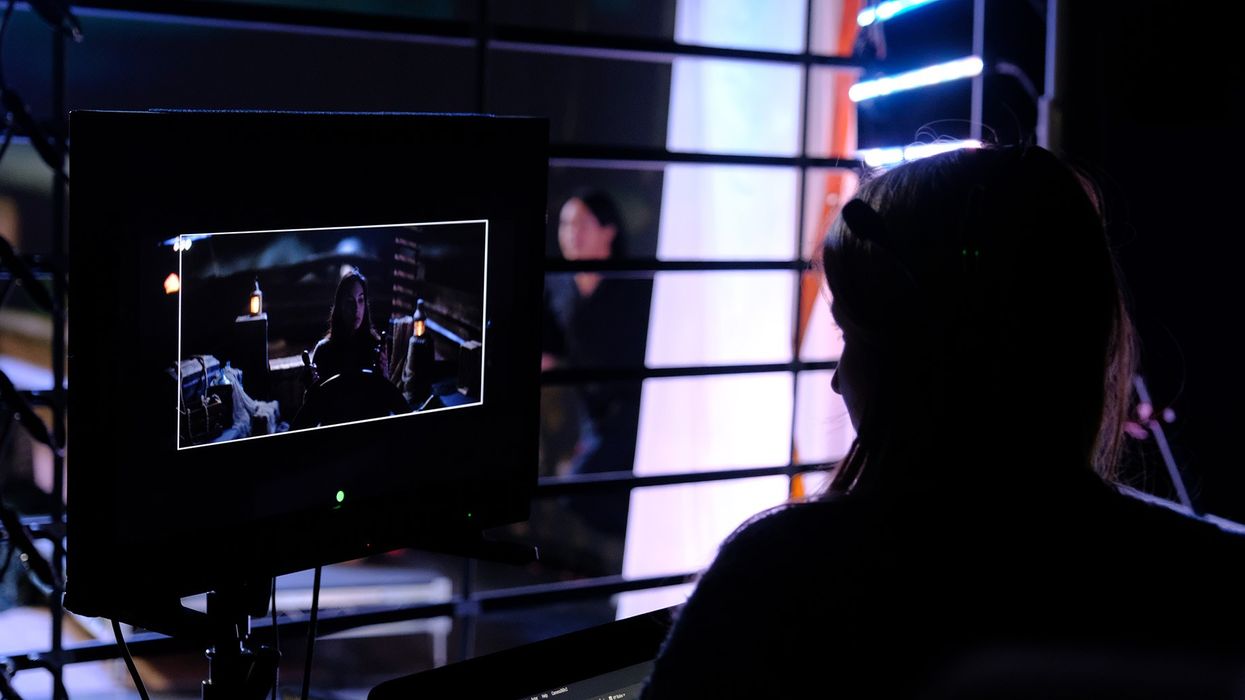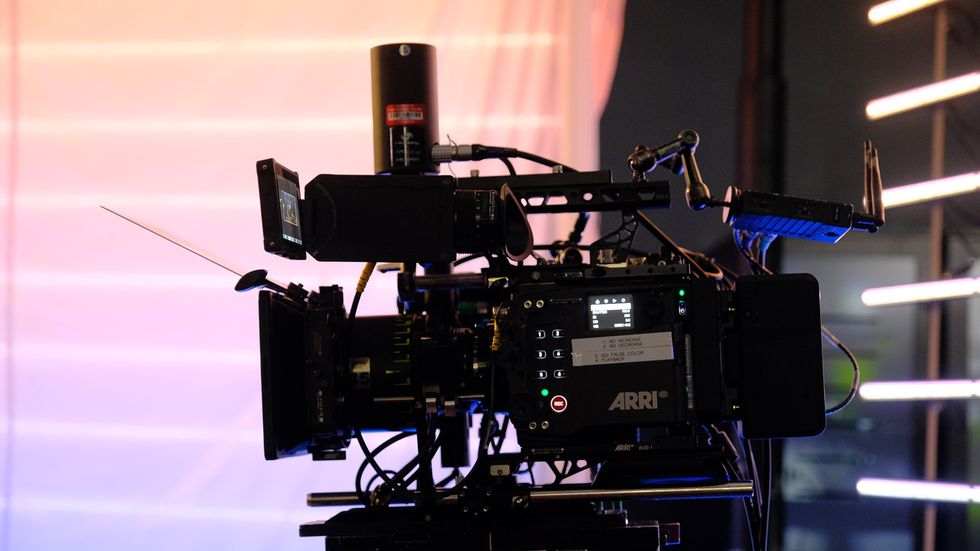Learning How To Work With LED Walls
As technology evolves at the speed of light, film schools have only just started to play catch up. LED panel manufactures are stepping in to fill the gap.

DP Indeana Underhill overseeing 'Doom Scroll'
at the ROE Visual studio
No matter how you learn to use a piece of technology, it's important to not only get hands-on time with your tools but to get direction from experts in the field. Even if you're just using YouTube and Google, expertise is the difference between education and mastery.
But what happens when you need to learn how to use technologies that may be cost-prohibitive? How would you learn how to shoot in a volume or with an LED wall?
ROE Visual, an LED creative display manufacturer in the virtual production space, had the same thought. Dipping into the experience the company collected during productions such as The Mandalorian (which used ROE’s Black Pearl 2 panels), the ROE Visual CaseStudy was born.
Here's everything I learned when I got a glimpse behind the LED curtain.
ROE Visual CaseStudy
Pioneered by ROE’s Business Development Manager, Bryan Larason, this nonprofit educational program aims to utilize the ROE Visual LED stage in Los Angeles to get cinematographers—with minimal virtual production experience—working with the technology firsthand.
“CaseStudy was born out of the realization that virtual production is not always accessible for a lot of DPs and filmmakers," Larason said. "And yet they’re expected to be up for bid against others who have extensive experience."
By bridging the gap and connecting participants with mentorship in the field," Larason explained, "we hope to get creatives more comfortable with including VP techniques in their workflow and demystify some of the misconceptions surrounding OSVP."
 The LED wall may not look like much from the wrong angle.
The LED wall may not look like much from the wrong angle. Credit: ROE
By embracing this approach of learning on the job, all while being supported by an expert in the field, the ROE Visual CaseStudy offers creatives the opportunity to make mistakes without risking a big production.
LED walls and volumes aren't cheap, after all.
Creatives in the program also get to work with the latest tech from ROE Visual, which we're sure lets the company better refine its tools before sending them out to big productions.
In late September of 2023, I was invited to shadow the CaseStudy production for Doom Scroll. Written and directed by John Michael Riva Jr. and shot by Director of Photography Indeana Underhill, the short piece was crafted from a feature-length film currently in development.
I spoke with both Riva and Underhill to learn more about their experience on set and what they learned.
 DP Indeana Underhill and Director John Michael Riva Jr.
DP Indeana Underhill and Director John Michael Riva Jr. Shooting An LED Wall
What was most interesting to me was how much actual prep went into an LED wall production. Even a DP with a prep-heavy workflow like Underhill found it a unique experience.
"I have always been very heavy on prep—emphasizing dogmatic approaches to planning for the creative, technical, and practical of my department," Underhill said. "Prep for VP worlds is massive, and so a constant reminder to always be prepared is key."
The short for Doom Scroll (formerly titled The Grey Man)was only five pages and included three separate scenes to be shot over a period of three days.
But to set these three days up, Riva and Underhill took five days.

Still from "Doom Scroll'. A few tufts of wheat blend the seams of virtual and live-action.
Indeana Underhill
"There were a lot more world-building conversations," Underhill said. Hours of storyboarding the shots, talking about limitations, and working with the Unreal artists to describe the world as we see it. References are an absolute must."
For Riva, prep was understanding one important thing—the transition from real to virtual.
"The biggest obstacle was understanding how the worlds created would look in the camera on the day," Riva said. "The volume and our practical props look very different from viewing it through the camera. The camera’s viewfinder is king."

Kadian Hall operating an ARRI Alexa Mini
Being on set, watching Riva and Underhill prep for the shoot, I had the same worry. The LED wall looks unrealistic when seeing it in real life, but once you see it through the camera, the lines between worlds start to blur.
This is thanks not only to lighting and composition but also to camera placement, lens choice, and even lens filters.
But the process wasn't just about building the world. Crucial technical steps also had to be included in pre-production. This included two days of lens mapping and testing, which allowed the LED wall to fake camera parallax using camera tracking.
A full day was also devoted to prelighting, where Riva, Underhill, and the Unreal team meticulously refined the lighting in their virtual scene.

DP Indeana Underhill works with the Unreal team to fine tune the virtual scene.
"What kind of grass do you want for your island? How much of it? What coast is it on? How much depth do you want to see? Should the sand dune be lower or higher?" Underhill explained.
Every little detail could be manipulated, giving the director and cinematographer immense control.
"We have control over every single element of our world," Underhill said. "Within Unreal, I can turn off specular highlights on individual objects."
Finding the right balance between detailed refinement and perfectionism was another big challenge. When you have the ability to control every single molecule of your scene...should you?
"The biggest issue here is how much control do we want?" Underhill said. "Also, who does it go to?"

Director John Michael Riva Jr. previews the composition.
This is what made Riva and Underhill's working relationship so important. Both the cinematographer and director balanced each other.
"The most significant difference I experienced was having the ability to change our environment on the fly," Riva said. "Do you hate that one light on a pirate ship casing an odd shadow? Delete it."
When you have the ability to control every aspect of your virtual world, knowing when to leave it alone or when to delegate the decision to someone else becomes a crucial part of your workflow.

Dustin Engelskind of the Unreal team.
"Since you have so much control over virtual light, objects, and background animations, playing Production Designer and even Cinematographer can be easy. That was the one thing that spooked me," Riva continued.
But even so, I saw how powerful this filmmaking technology could be in the hands of creatives who know how to use it. It connected every member of the crew as if they were on-location using real-world locations.
"Virtual production makes filmmaking more accessible to the entire crew," Underhill shared. "We aren’t waiting to see how the world is built later in VFX. We can see it as we are lighting, designing, and having talent interact with the world around them that we have control over."
 Still from "Doom Scroll'. Only the actor and the couch they are sitting on is real.Indeana Underhill
Still from "Doom Scroll'. Only the actor and the couch they are sitting on is real.Indeana UnderhillWhat Did I Learn?
Being a filmmaker myself, it was a unique experience witnessing a virtual production as a fly on the wall. Not being part of the image pipeline or decision-making process allowed me to see how the things Riva and Underhill talked about unfold throughout production and prep.
An LED wall or volume is definitely a powerful toolkit. Much like VFX, it allows for the creation of worlds that don't exist. But it then shows you that world in real-time. If done right, an entire VFX-heavy project can be shot in-camera.
Yet the challenges of everyday filmmaking remain the same, even if some of them are shuffled into a different section of the filmmaking process.

When set up, the camera blurs the line between real and virtual.
Virtual Production for Beginners: A Case Study (Panel)
What VFX artists would do in post, they now do in prep. Because your virtual world is shown for all to see, you're creative vision is so much more important. Being clear about your vision and creative intentions has never been more crucial. Communication is key, but so is not stepping on other people's toes. It takes a village to make a film, which means letting your crew do the work.
But now that we can see everything on an LED wall, you don't have to wait till the final render to see how it all came together.
To explore the production of Doom Scroll a bit more, the production team joined We Make Movies and Cinematography For Actors for a livestream educational panel on working in the VP space.
Where Does CaseStudy Go From Here?
Because the program is still in its infancy, CaseStudy is still undergoing changes, and we can expect improvements to how it's implemented and what creatives can get from the experience.
The CaseStudy program will undergo a restructuring in 2024, allowing prospective participants to apply directly on the ROE Visual website. Changes to the program will enhance the pre-production process and overall structure of CaseStudy with a strong focus on mentorship.
In the meantime, for more information about ROE, visit the ROE Visual website.













